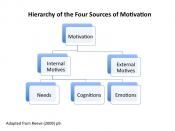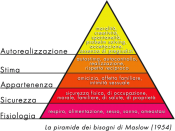Motivation is a very important process in understanding behaviour. In an organization, the effectiveness of a manager can be determined from his leadership ability in order to achieve personal and organizational goals. In simple words, motivation is to understand the 'why' of a human behaviour. Another definition according to J Stoner, motivation is the factors that cause, channel and sustain an individual's behaviour.
The Theories of motivation consists of two main theories which include content theories and process theories. Content theories concerns with 'what' motivates people. These theories are concerned with identifying needs or drives that people have and how these are prioritised. While process theories concerns with 'how' behaviour is started, sustained, and terminated, where motivation is seen as an outcome of complex interaction between people.
The first content theory of motivation is the Hierarchy of Needs (Maslow, 1954). Maslow developed a hierarchy of needs in ascending order which, once one was fulfilled would lead on to the fulfilment of the next.
This need for successive fulfilment becomes a motivator. Their behaviour will be directed by their desire to get their needs. For example, if people need food their behaviour will be directed by their desire to get some food. He thought that the workplace could be an environment where people could have their needs met. Lower order needs must be partially satisfied before a higher order need is pursued. The only motivating need is an unfilled need.
Abraham Maslow (1908 - 1970) was an American psychologist whose great contribution to motivation theory is the 'Hierarchy of Needs'. Maslow believed that everyone has the same needs - all of which can be organized as a hierarchy. He postulated that workers have five basic needs which can be ranked in order of ascending importance. The first three needs; physiological, safety...


